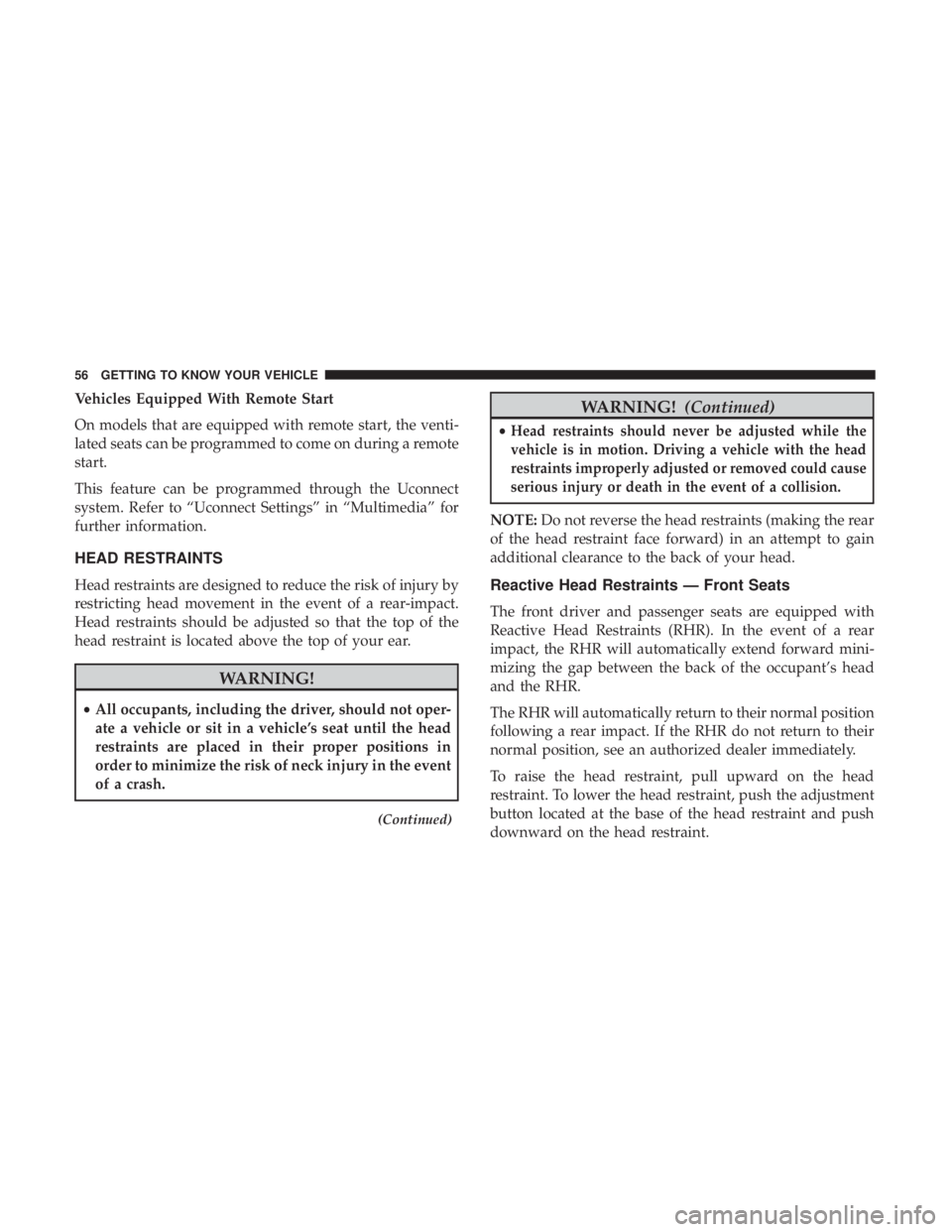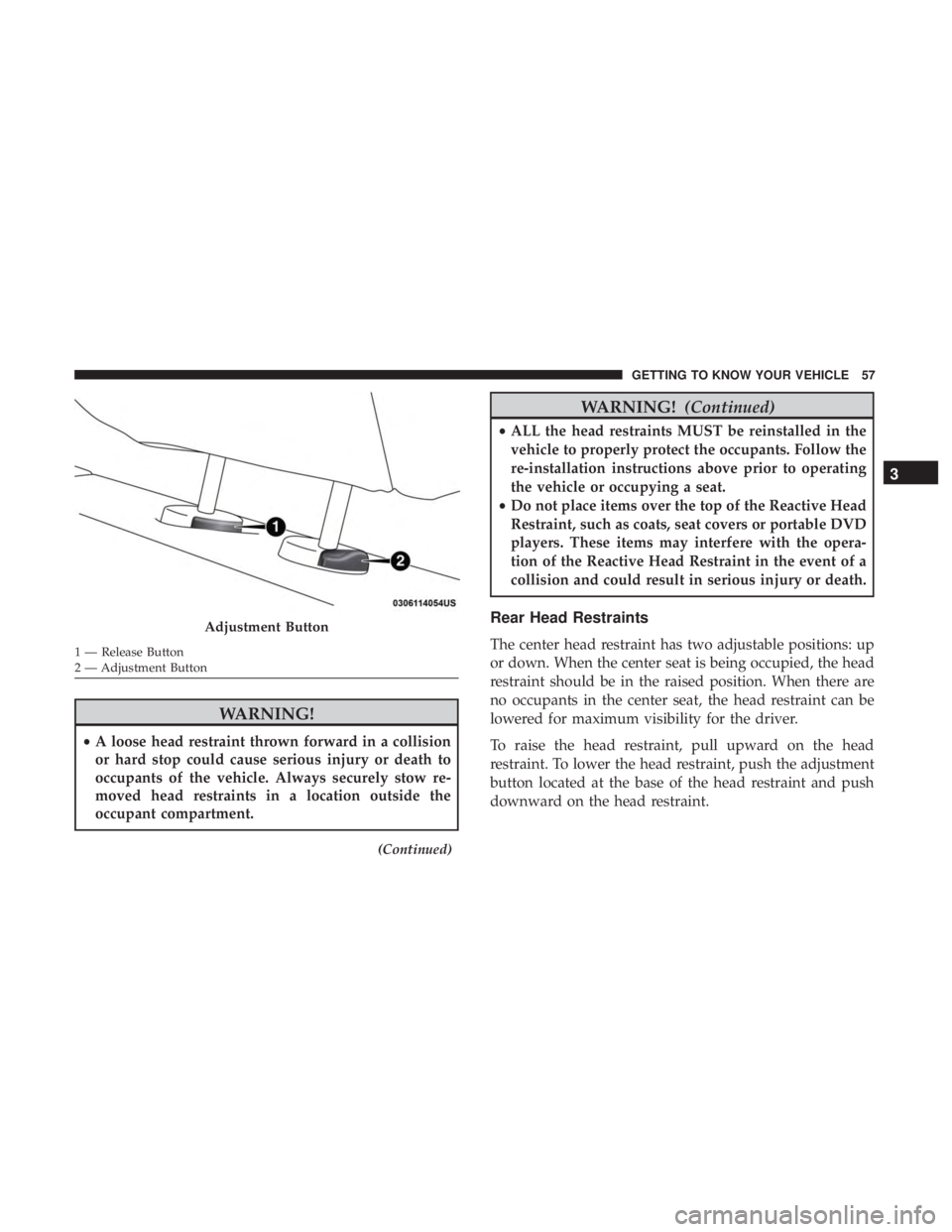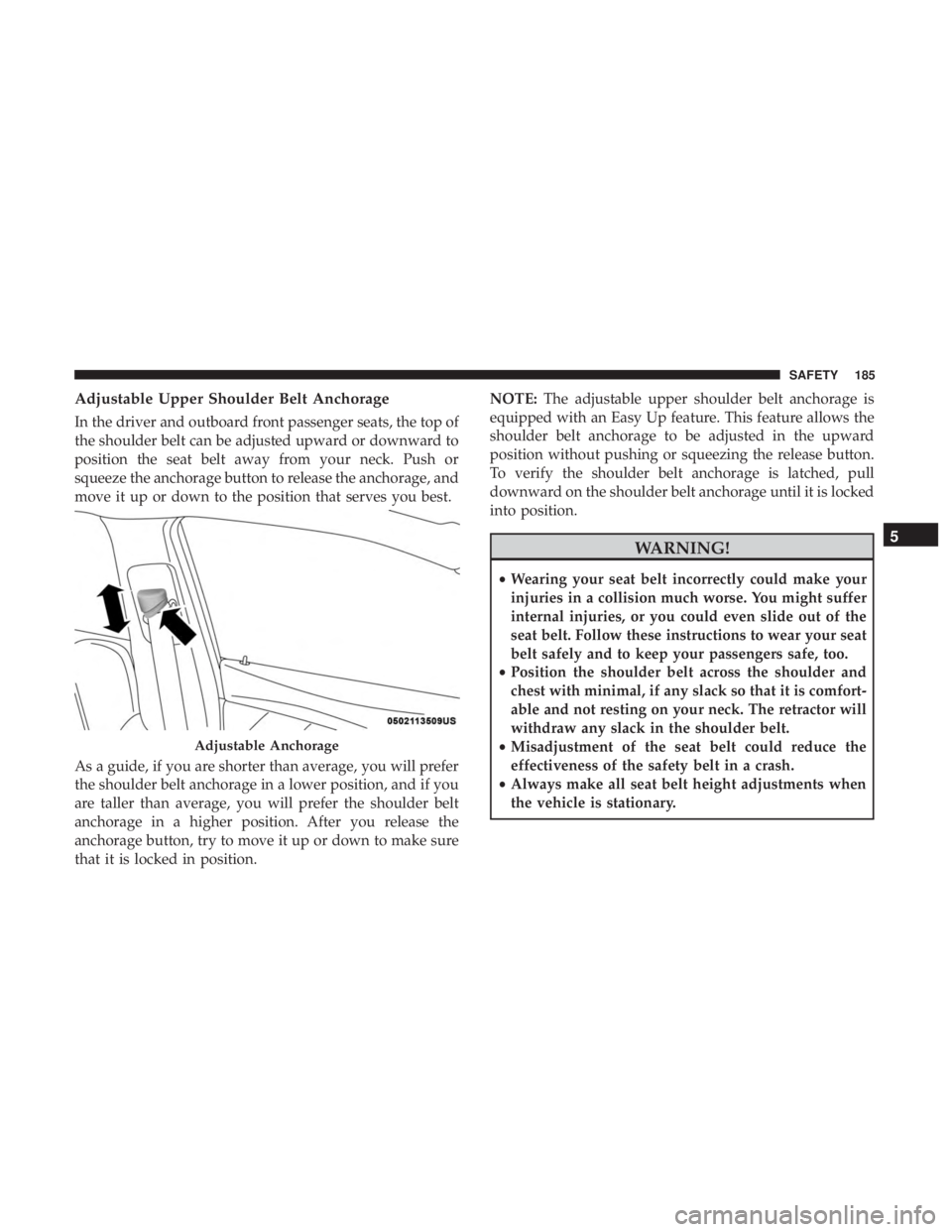Page 16 of 560

▫Keyless Enter-N-Go — Passive Entry .........38
▫ Automatic Unlock Doors On Exit ............42
▫ Automatic Door Locks — If Equipped ........42
▫ Child-Protection Door Lock System —
Rear Doors ............................42
� SEATS ................................43
▫ Manual Adjustment (Front Seats) —
If Equipped ...........................44
▫ Manual Rear Seat Adjustment ...............46
▫ Power Seats — If Equipped ................48
▫ Driver Memory Seat — If Equipped ..........50
▫ Heated Seats — If Equipped ................53
▫ Front Ventilated Seats — If Equipped .........55
� HEAD RESTRAINTS ......................56
▫ Reactive Head Restraints — Front Seats .......56
▫ Rear Head Restraints ....................57
▫ Front Head Restraint Removal ..............58�
STEERING WHEEL .......................59
▫ Manual Tilt/Telescoping Steering Column —
If Equipped ...........................59
▫ Power Tilt/Telescoping Steering Column —
If Equipped ............................60
▫ Heated Steering Wheel — If Equipped .........61
� MIRRORS ..............................62
▫ Inside Day/Night Mirror — If Equipped ......62
▫ Automatic Dimming Mirror — If Equipped .....62
▫ Outside Mirrors ........................63
▫ Driver’s Outside Automatic Dimming Mirror —
If Equipped ............................64
▫
Outside Mirrors Approach Light — If Equipped . . .64
▫ Power Mirrors .........................64
▫ Heated Mirrors — If Equipped .............65
▫ Tilt Side Mirrors In Reverse — If Equipped .....65
▫ Illuminated Vanity Mirrors — If Equipped .....65
14 GETTING TO KNOW YOUR VEHICLE
Page 58 of 560

Vehicles Equipped With Remote Start
On models that are equipped with remote start, the venti-
lated seats can be programmed to come on during a remote
start.
This feature can be programmed through the Uconnect
system. Refer to “Uconnect Settings” in “Multimedia” for
further information.
HEAD RESTRAINTS
Head restraints are designed to reduce the risk of injury by
restricting head movement in the event of a rear-impact.
Head restraints should be adjusted so that the top of the
head restraint is located above the top of your ear.
WARNING!
•All occupants, including the driver, should not oper-
ate a vehicle or sit in a vehicle’s seat until the head
restraints are placed in their proper positions in
order to minimize the risk of neck injury in the event
of a crash.
(Continued)
WARNING! (Continued)
•Head restraints should never be adjusted while the
vehicle is in motion. Driving a vehicle with the head
restraints improperly adjusted or removed could cause
serious injury or death in the event of a collision.
NOTE: Do not reverse the head restraints (making the rear
of the head restraint face forward) in an attempt to gain
additional clearance to the back of your head.
Reactive Head Restraints — Front Seats
The front driver and passenger seats are equipped with
Reactive Head Restraints (RHR). In the event of a rear
impact, the RHR will automatically extend forward mini-
mizing the gap between the back of the occupant’s head
and the RHR.
The RHR will automatically return to their normal position
following a rear impact. If the RHR do not return to their
normal position, see an authorized dealer immediately.
To raise the head restraint, pull upward on the head
restraint. To lower the head restraint, push the adjustment
button located at the base of the head restraint and push
downward on the head restraint.
56 GETTING TO KNOW YOUR VEHICLE
Page 59 of 560

WARNING!
•A loose head restraint thrown forward in a collision
or hard stop could cause serious injury or death to
occupants of the vehicle. Always securely stow re-
moved head restraints in a location outside the
occupant compartment.
(Continued)
WARNING! (Continued)
•ALL the head restraints MUST be reinstalled in the
vehicle to properly protect the occupants. Follow the
re-installation instructions above prior to operating
the vehicle or occupying a seat.
• Do not place items over the top of the Reactive Head
Restraint, such as coats, seat covers or portable DVD
players. These items may interfere with the opera-
tion of the Reactive Head Restraint in the event of a
collision and could result in serious injury or death.
Rear Head Restraints
The center head restraint has two adjustable positions: up
or down. When the center seat is being occupied, the head
restraint should be in the raised position. When there are
no occupants in the center seat, the head restraint can be
lowered for maximum visibility for the driver.
To raise the head restraint, pull upward on the head
restraint. To lower the head restraint, push the adjustment
button located at the base of the head restraint and push
downward on the head restraint.
Adjustment Button
1 — Release Button
2 — Adjustment Button
3
GETTING TO KNOW YOUR VEHICLE 57
Page 187 of 560

Adjustable Upper Shoulder Belt Anchorage
In the driver and outboard front passenger seats, the top of
the shoulder belt can be adjusted upward or downward to
position the seat belt away from your neck. Push or
squeeze the anchorage button to release the anchorage, and
move it up or down to the position that serves you best.
As a guide, if you are shorter than average, you will prefer
the shoulder belt anchorage in a lower position, and if you
are taller than average, you will prefer the shoulder belt
anchorage in a higher position. After you release the
anchorage button, try to move it up or down to make sure
that it is locked in position.NOTE:
The adjustable upper shoulder belt anchorage is
equipped with an Easy Up feature. This feature allows the
shoulder belt anchorage to be adjusted in the upward
position without pushing or squeezing the release button.
To verify the shoulder belt anchorage is latched, pull
downward on the shoulder belt anchorage until it is locked
into position.
WARNING!
• Wearing your seat belt incorrectly could make your
injuries in a collision much worse. You might suffer
internal injuries, or you could even slide out of the
seat belt. Follow these instructions to wear your seat
belt safely and to keep your passengers safe, too.
• Position the shoulder belt across the shoulder and
chest with minimal, if any slack so that it is comfort-
able and not resting on your neck. The retractor will
withdraw any slack in the shoulder belt.
• Misadjustment of the seat belt could reduce the
effectiveness of the safety belt in a crash.
• Always make all seat belt height adjustments when
the vehicle is stationary.
Adjustable Anchorage
5
SAFETY 185